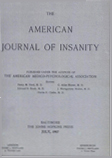A REVIEW OF OUR PRESENT KNOWLEDGE CONCERNING THE SERO-DIAGNOSIS OF GENERAL PARALYSIS
Abstract
In attempting to formulate a judgment over these seven new methods for the diagnosis of luetic disease, we can deal with some very briefly. The Landsteiner-Mucha agglutination phenomenon and the Neisser-Wolff-Eisner reaction have up to the present not been sufficiently investigated to enable us to see how useful they will ultimately prove to be. Difficulties in connection with the cultural characteristics of the Treponema warn us against being too sanguine about any early practical result being reached by this route.
Three other methods, those of Klausner, Michaelis, and Fornet-Schereschewsky respectively, have been carefully investigated by skilled workers, notably Plaut and others, and do not seem to have stood the ordeal well. The evidence before us points strongly to the conclusion that at present they have not been sufficiently developed to be regarded as in any sense specific reactions, or even to be characteristic enough of lues to be of any practical value. They all however point to what may be fruitful lines of research for the future.
The Porges-Meier reaction is of great theoretic interest on account of the study it affords of the relation between luetic serum and certain lipoid bodies, and the light it thus indirectly throws on the nature of the Wassermann phenomenon. On the clinical side it appears to be of some value in the diagnosis of syphilis in its various stages, although it assuredly cannot be regarded as a specific phenomenon nor as one rivaling in accuracy of results the Wassermann reaction.
The Wassermann reaction is beyond all doubt the test of the greatest interest and importance among those under consideration. Its great practical value and precise diagnostic indications, particularly in connection with psychiatry, have already been summarized in the corresponding section of this review, and need not again be repeated, so that it only remains shortly to express what seems to be most certain in regard to its essential nature.
The reaction may be evoked not only by the use of syphilitic liver extract as antigen, but by a large series of substances, most, or perhaps all, of which are of a lipoid nature. These lipoids are probably present in especially large quantities in syphilitic organs. but there is no reason why they should occur to some extent in other material. They act on the blood serum, or cerebro-spinal fluid as the case may be, of syphilitics by interacting, probably as a precipitation phenomenon, with some substance that is contained in euglobulin; the combination has the power of combining with complement, and thus of inhibiting hæmolysis.
The substance in the serum is a normal constituent thereof and has of itself some anti-hæmolytic power, which is increased during the interaction just mentioned. Whether the increase of this substance that takes place in syphilis originates in the luetic agent itself, or is evoked as an anti-body in response to the syphilitic infection or in response to the tissue disintegration caused by this infection are questions as yet unanswered. Affinity for lipoids, notably for lecithin, appears to be one of its characteristic attributes, and it is possible that this may be important, not only in the Wassermann reaction, but in relation to the morbid processes in the body induced by the syphilitic infection.
Access content
To read the fulltext, please use one of the options below to sign in or purchase access.- Personal login
- Institutional Login
- Sign in via OpenAthens
- Register for access
-
Please login/register if you wish to pair your device and check access availability.
Not a subscriber?
PsychiatryOnline subscription options offer access to the DSM-5 library, books, journals, CME, and patient resources. This all-in-one virtual library provides psychiatrists and mental health professionals with key resources for diagnosis, treatment, research, and professional development.
Need more help? PsychiatryOnline Customer Service may be reached by emailing [email protected] or by calling 800-368-5777 (in the U.S.) or 703-907-7322 (outside the U.S.).



